Usability of web interfaces
| Rate | |||
| Criteria Evaluation | |||
transferable adaptability innovative acceptability impact effectiveness availability creativity collaborative
EL
ES
HR
DE
FR
HU
PL
View the translated version |
|
The good teaching practice at a glance
scientific
Learner
Higher Education
Through this practice students learn the principles of good design. They use a range of methods to conduct quantitative and qualitative usability evaluation. They also learn the methodology for usability questionnaire development through practical hands-on experience. Finally, the students achieve cross cultural experience with usage and validation of the questionnaire.
2015-04-27 05:15:00 - 2015-06-12 17:15:00
Detailed description
20 - 35
Knowledge of web interface design. Competences on usability evaluation methods.
7 weeks
GENERAL INFORMATION
- University of Split, Faculty of Science, Croatia
- 7 weeks duration (27.04. – 12.06. 2015)
- 70 students as participants organized in 20 groups of 3 or 4
- undergraduate and graduate students of computer science
- form of workshops
- 3 teachers as workshop leaders
- workshop on web interface usability in 7 steps
- 1st step: analyzing interfaces of various specific web sites - web portals
- 2nd step: choosing one poorly designed web portal interface for redesign
- 3rd step: quantitative and qualitative usability evaluation using a range of methods
- 4th step: usability questionnaire development - USPA (Usability Subjective Portal Assessment)
- 5th step: new design of web portal interface
- 6th step: cross cultural evaluation with USPA questionnaire
- 7th step: group presentations of workshop results
- ICT enabled learning - Using digital resources for face-to-face classroom practice & for online learning/blended classroom practice
- Community Building - Using digital resources to connect learners/build communities
- Quality and Assessment - Using digital resources to better assess learning
About the author
| Name of contributor | Nikola Marangunić |
| Affiliation of contributor | Professor |
| Institution where this practice was implemented | Faculty of Science, University of Split, Croatia |
| Contact e-mail | nikola@pmfst.hr |
- Log in to post comments


